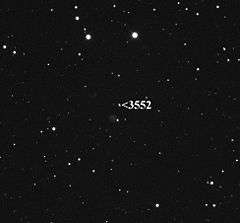3552 Don Quixote
|
| |
| Discovery [1] | |
|---|---|
| Discovered by | P. Wild |
| Discovery site | Zimmerwald Obs. |
| Discovery date | 26 September 1983 |
| Designations | |
| MPC designation | 3552 Don Quixote |
Named after | Don Quixote[2] |
| 1983 SA | |
|
NEA, Amor (IV) Mars-crosser Jupiter-crosser | |
| Orbital characteristics [1] | |
| Epoch 13 January 2016 (JD 2457400.5) | |
| Uncertainty parameter 0 | |
| Observation arc | 11885 days (32.54 yr) |
| Aphelion | 7.2531 AU (1.08505 Tm) |
| Perihelion | 1.2204 AU (182.57 Gm) |
| 4.2367 AU (633.80 Gm) | |
| Eccentricity | 0.71195 |
| 8.72 yr (3185.3 d) | |
Average orbital speed | 12.41 km/s |
| 264.55° | |
| 0° 6m 46.872s / day | |
| Inclination | 31.210° |
| 350.02° | |
| 316.90° | |
| Earth MOID | 0.312024 AU (46.6781 Gm) |
| Jupiter MOID | 0.439467 AU (65.7433 Gm) |
| Jupiter Tisserand parameter | 2.312 |
| Physical characteristics | |
| Dimensions | 18.4 km[3] |
Mean radius | 9.5 km |
| 7.7 h (0.32 d)[1][4] | |
| 0.03[1][3] | |
| Temperature | ~ 138 K |
| D (Tholen), D (SMASS) | |
| 11.67 (1957) to 22.32[lower-alpha 1] | |
| 12.9 | |
|
| |
3552 Don Quixote, provisionally designated 1983 SA, is a near-Earth asteroid (NEA), also classified as Amor, Mars-crossing, and Jupiter-crossing asteroid. It has a highly inclined comet-like orbit of 31 degrees that leads to frequent perturbations by Jupiter.[5] Don Quixote measures 18.4 kilometres in diameter and has a rotation period of 7.7 hours.[1][3] It was discovered by Paul Wild at the Swiss Zimmerwald Observatory in 1983, and is named after the comic knight who is the eponymous hero of Cervantes' Spanish novel Don Quixote (1605).[1][2]
Due to its comet-like orbit and albedo, Don Quixote has ever been suspected to be an extinct comet.[6] However, infrared observations with the Spitzer Space Telescope at 4.5 μm revealed a faint coma and tail around the object.[3] The cometary activity is interpreted as CO2 molecular band emission. It is not clear if the observed activity is persistent or an outburst, resulting from the excavation of sub-surface CO2 ice due to a recent impact of a smaller body.
Notes
- ↑ Magnitudes generated with JPL Horizons for the year 1950 through 2100
References
- 1 2 3 4 5 6 "JPL Small-Body Database Browser: 3552 Don Quixote (1983 SA)" (16 March 2015 last obs.). Jet Propulsion Laboratory. Retrieved 14 April 2016.
- 1 2 "Dictionary of Minor Planet Names – (3552) Don Quixote". Springer Berlin Heidelberg. 2007. p. 298. Retrieved 10 October 2015.
- 1 2 3 4 M. Mommert; J. L. Hora; A. W. Harris; W. T. Reach; J. P. Emery; et al. (January 2014). "The Discovery of Cometary Activity in Near-Earth Asteroid (3552) Don Quixote". Astrophysical Journal (781): 25. arXiv:1312.0673
 . Bibcode:2014ApJ...781...25M. doi:10.1088/0004-637X/781/1/25.
. Bibcode:2014ApJ...781...25M. doi:10.1088/0004-637X/781/1/25. - ↑ "European Asteroid Research Node:(3552) Don Quixote". Retrieved 8 March 2014.
- ↑ "JPL Close-Approach Data: 3552 Don Quixote (1983 SA)" (2 May 2009 last obs). Retrieved 6 May 2009.
- ↑ D.F. Lupishko; M. di Martino & T.A. Lupishko (September 2000). "What the physical properties of near-Earth asteroids tell us about sources of their origin?". Kinematika i Fizika Nebesnykh Tel Supplimen (3): 213–216. Bibcode:2000KFNTS...3..213L.
External links
- Orbital simulation from JPL (Java) / Ephemeris
- 3552 Don Quixote at the JPL Small-Body Database

